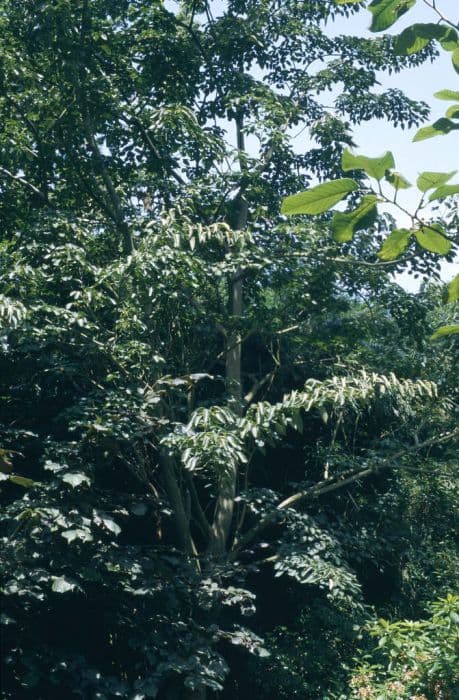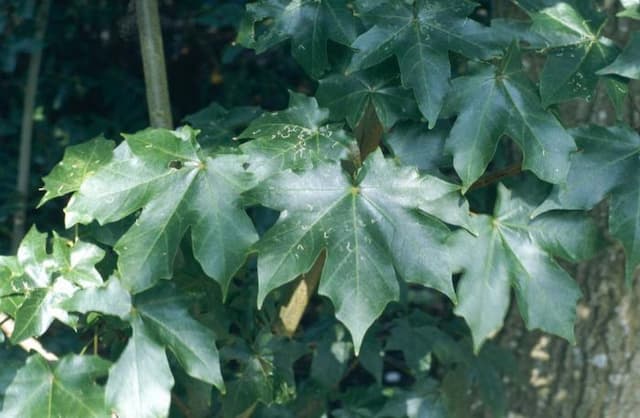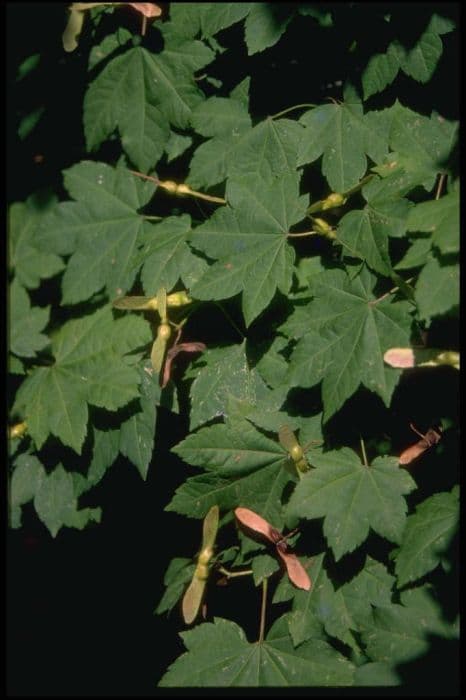Japanese Maple Acer palmatum 'Orangeola' (D)

ABOUT
The Japanese maple 'Orangeola' is renowned for its striking foliage and graceful growth habit. This elegant ornamental tree presents a compelling visual display throughout the seasons. In the spring, its leaves emerge with a vivid orange hue, gradually transitioning to a luscious green shade tinged with orange undertones in summer. As autumn approaches, the leaves transform yet again, adopting fiery tones of orange and red, giving the tree its name and autumnal splendor. The leaves of the 'Orangeola' are finely dissected, featuring a lace-like quality that is characteristic of many Japanese maples. The intricate leaf structure contributes to the plant's delicate and feathery appearance. Each leaf typically has multiple lobes that are deeply cut, almost to the leaf base, radiating outwards like the palm of a hand with splayed fingers, enhancing its ornamental appeal. The growth habit of 'Orangeola' is notable for its cascading branches that can create a weeping effect, lending a sense of elegance and movement to the silhouette of the tree. Over time, the branches develop in a layered fashion, providing visual interest and depth to its overall form. This diverse combination of color and form makes 'Orangeola' a prized specimen in many gardens, where it can serve as a focal point throughout the year. Its beauty is not limited to the foliage; the bark of this Japanese maple provides winter interest with its subtle texture and color, contributing to the tree's year-round appeal.
About this plant
 Names
NamesFamily
Sapindaceae
Synonyms
Orangeola Japanese Maple
Common names
Acer palmatum 'Orangeola'
 Toxicity
ToxicityTo humans
The Japanese Maple is generally not toxic to humans. There are no widespread reports of poisoning from ingesting parts of this plant, and it is not known to cause any significant symptoms if accidentally consumed. However, as with any plant material, individuals may have allergies or sensitivities that could cause mild stomach upset or dermatitis on contact with the sap or leaves.
To pets
The Japanese Maple is also considered non-toxic to pets. It is not commonly associated with poisoning in animals, such as dogs and cats, and there should be no significant symptoms if pets ingest parts of this plant. Nevertheless, keeping an eye on pets and preventing them from eating plant material is always a good precaution to avoid any potential stomach upset due to individual sensitivities.
 Characteristics
CharacteristicsLife cycle
Perennials
Foliage type
Deciduous
Color of leaves
Mixed
Height
4-5 feet (1.2-1.5 meters)
Spread
4-5 feet (1.2-1.5 meters)
Plant type
Tree
Hardiness zones
5-9
Native area
Japan
Benefits
 General Benefits
General Benefits- Visual Interest: The 'Orangeola' Japanese Maple is known for its stunning orange-red foliage, which adds vibrant color and visual interest to landscapes and gardens.
- Seasonal Beauty: This cultivar provides year-round beauty with its changing leaf colors throughout the seasons—from bright green in spring to fiery orange in fall.
- Shade Tolerance: It can thrive in partial shade, making it suitable for gardens with varied light conditions.
- Compact Size: With its moderate growth rate and size, the 'Orangeola' is ideal for smaller gardens or as a specimen in larger landscapes.
- Ease of Pruning: Pruning to shape or maintain its size can be done with minimal effort, making it a good choice for those seeking a low-maintenance option.
- Attracts Wildlife: The tree can attract birds and butterflies, enhancing the biodiversity of the garden environment.
- Cooling Effect: Like other trees, it can contribute to a cooling effect in the garden, providing shade and reducing heat during the hot summer months.
- Durability: It is relatively hardy, able to withstand cold winters in many climates.
- Versatility in Landscaping: It can be used in various landscape designs, including traditional Japanese gardens, contemporary settings, or as a potted specimen on patios and decks.
 Medical Properties
Medical PropertiesThis plant is not used for medical purposes.
 Air-purifying Qualities
Air-purifying QualitiesThis plant is not specifically known for air purifying qualities.
 Other Uses
Other Uses- Acer palmatum 'Orangeola' leaves can be pressed and used in scrapbooking or other paper crafts for their distinctive shape and color, adding an organic touch to creative projects.
- The thin branches of this Japanese maple can be used in model-making for realistic miniature trees, particularly in railroad models or architectural presentations.
- Dried leaves of 'Orangeola' can be incorporated into potpourri mixes, contributing to the visual appeal with their unique color and texture.
- The wood from pruned branches may be used for smoking food, imparting a subtle, sweet flavor to meats and cheeses.
- Leaves can serve as natural stencils for painting or spray-painting projects, creating beautiful and intricate designs.
- Japanese maple sap, while not commonly tapped like sugar maples, could be used experimentally in homemade syrup making.
- The vibrant foliage can be used in photography as a natural backdrop or to add a splash of color in macro photography.
- 'Orangeola' can be utilized in bonsai art, for either the leaves or branches, contributing to the aesthetic of miniature landscapes.
- Dried and varnished leaves can be used in handmade jewelry such as pendants or earrings, preserved in their colorful state.
- The gentle rustling of the leaves in the wind can be harnessed as a natural sound element in music recordings or sound therapy sessions.
Interesting Facts
 Feng Shui
Feng ShuiThe Japanese Maple is not used in Feng Shui practice.
 Zodiac Sign Compitability
Zodiac Sign CompitabilityThe Japanese Maple is not used in astrology practice.
 Plant Symbolism
Plant Symbolism- Beauty and Elegance: The 'Orangeola' Japanese Maple is a cultivar prized for its graceful form and stunning foliage, often symbolizing aesthetic beauty and elegance in the garden.
- Peace and Tranquility: With its calming presence, Japanese Maples are often associated with creating an atmosphere of peace and tranquility, making them popular in zen gardens.
- Balance and Harmony: The balanced growth and change of colors throughout the seasons can represent the idea of harmony with nature and the balance of life's cycles.
- Endurance and Patience: As a perennial tree that experiences and withstands the changing seasons, it symbolizes the need for endurance and patience in life.
 Water
WaterThe Japanese maple 'Orangeola' prefers evenly moist soil, so it's important to water it regularly, especially during dry periods. For young trees or those in containers, water every 2 to 3 days, providing about 1 to 2 gallons each time, depending on the size and soil drainage. Mature trees in the ground require less frequent watering, perhaps once a week, applying approximately 15 gallons to ensure deep soil penetration. During hot weather, you may need to increase the frequency, but always check the soil moisture first to avoid overwatering, which can lead to root rot. Reduce watering in the fall and winter when the tree is dormant.
 Light
LightThe Japanese maple 'Orangeola' thrives best in partial shade to full sun. An ideal spot would be one where the tree gets morning sunlight but is protected from the harsh afternoon sun, especially in climates with very hot summers. Dappled shade under taller trees can also provide the perfect light conditions, ensuring the delicate leaves aren't scorched by intense sun exposure.
 Temperature
TemperatureThe Japanese maple 'Orangeola' is hardy and can tolerate a diverse range of temperatures, from as low as 20 to 25 degrees Fahrenheit up to about 90 degrees Fahrenheit. The ideal temperature range for this tree to thrive is between 60 and 70 degrees Fahrenheit. These trees can withstand brief periods outside these ranges, but prolonged exposure to extremes can be damaging.
 Pruning
PruningPrune the Japanese maple 'Orangeola' to maintain its shape, encourage healthy growth, and remove any dead or damaged branches. The best time to prune is during the late winter or early spring before the sap starts to flow. Pruning is typically needed once a year, but minimal trimming can be done at any time if necessary to address specific issues.
 Cleaning
CleaningAs needed
 Soil
SoilThe Japanese Maple 'Orangeola' thrives in well-draining, acidic to neutral soil with a pH of around 5.5 to 7.5. A good soil mix for this tree would include a blend of loamy soil, peat moss, and coarse sand or pine bark to enhance drainage and aeration.
 Repotting
RepottingJapanese Maples like 'Orangeola' typically need repotting every 2-3 years when young. As they mature and growth slows, they can be repotted less frequently, such as every 4-5 years, to refresh the soil and prevent root binding.
 Humidity & Misting
Humidity & MistingJapanese Maple 'Orangeola' prefers moderate humidity levels but can tolerate a range of conditions. Aim for about 40-60% humidity, which is generally the average in temperate climates, for optimal growth.
 Suitable locations
Suitable locationsIndoor
Ensure bright light, cool room, and protect from dry heat for indoor 'Orangeola' care.
Outdoor
Plant in partial shade, protect from strong winds, and mulch well for 'Orangeola'.
Hardiness zone
5-8 USDA
 Life cycle
Life cycleJapanese Maple 'Orangeola' starts its life as a seed, typically germinating in the spring when conditions of moist soil and warmer temperatures trigger the start of growth. The seed grows into a sapling, with the iconic lobed leaves of the Acer palmatum species developing as it matures. Over several years, the sapling will grow into a mature tree, reaching up to 4-5 meters in height, with a cascading habit and branches bearing reddish-orange foliage that changes color throughout the seasons. During adulthood, it produces small, inconspicuous flowers in spring, which, if pollinated, develop into samaras, the winged fruit typical of maples, that disperse with the wind to propagate new trees. The tree has a deciduous habit, shedding its leaves in the fall to conserve energy during the dormant winter months. This cycle of growth, reproduction, and dormancy continues annually throughout the Japanese Maple 'Orangeola's lifespan, which can extend to over a century in optimal conditions.
 Propogation
PropogationPropogation time
Spring-Early Summer
The most popular method of propagating the Japanese Maple 'Orangeola' is through softwood cuttings taken in late spring or early summer when the tree's new growth is just beginning to harden. Select a healthy branch and cut a 4 to 6-inch (10 to 15 cm) length, making sure there are at least two to three pairs of leaves. Remove the leaves from the lower half of the cutting to expose the nodes where roots will form. Dip the cut end into a rooting hormone powder to encourage root growth. Plant the cutting in a mix of half peat and half perlite or sand, ensuring the exposed nodes are buried. Keep the soil consistently moist and cover the cutting with a plastic bag to maintain humidity. Roots typically develop within a few weeks, after which the new sapling can be carefully transplanted into a larger pot or directly into the garden.





![Freeman maple [Autumn Blaze]](/_next/image?url=https%3A%2F%2Fplants-admin.emdemapps.com%2Fimages%2Fplants%2F%2Fimages%2F604b575b84d87.png&w=640&q=75)



